Why this resume works
- Quantifies accomplishments: Measurable accomplishments, such as redesigning office space to boost efficiency by 30%, showcase the applicant’s tangible contributions.
- Highlights industry-specific skills: Industry-specific skills like spatial planning and AutoCAD are highlighted through projects managed with budgets up to $200K, reflecting the applicant’s strong fit for interior design roles.
- Showcases career progression: Showcasing career progression from junior designer to managing substantial budgets as an interior designer reflects increasing responsibilities and a clear trajectory of growth in the field.
More Interior Designer Resume Examples
These interior designer resume examples show how to highlight your creativity, space planning, and design skills. Use them to create an interior design resume that highlights your experience and stands out.
Entry-Level Interior Designer
Why this resume works
- Puts skills at the forefront: By placing key skills like AutoCAD and 3D rendering at the forefront, this skills-based resume format appeals directly to entry-level opportunities.
- Shows digital literacy: With skill in tools like AutoCAD and Revit, the applicant showcases computer skills and digital readiness for modern design challenges.
- Centers on academic background: The education section highlights a strong academic foundation with advanced degrees focusing on sustainable design, important for starting a career in interior design.
Mid-Level Interior Designer
Why this resume works
- Demonstrates language abilities: Language skills in Spanish, French, and Italian support seamless collaboration on international design projects and strengthen cross-cultural client communication.
- Points to measurable outcomes: Quantifiable outcomes, like boosting client base by 30% and reducing costs by 15%, highlight the applicant’s ability to deliver impactful results across diverse interior design roles.
- Displays technical expertise: Expertise in AutoCAD, sustainable design certifications like LEED Green Associate, and a history of award-winning projects emphasize technical mastery essential for innovative space planning.
Experienced Interior Designer
Why this resume works
- Showcases impressive accomplishments: Through accomplishments like orchestrating award-winning projects, the applicant exhibits impactful performance and senior-level expertise in the design industry.
- Focuses on work history: By organizing roles from recent to earliest, the applicant’s chronological resume effectively showcases a rich work history spanning over a decade.
- Emphasizes leadership skills: Managing 10 commercial projects annually highlights the applicant’s leadership skills, showcasing an ability to lead teams and deliver results consistently.
Interior Designer Resume Template (Text Version)
Ming Johnson
Southgate, MI 48200
(555)555-5555
Ming.Johnson@example.com
Professional Summary
Innovative interior designer with 5 years’ experience transforming spaces, driving client satisfaction, and managing projects exceeding $200K. Expert in sustainable design and AutoCAD, with a focus on efficiency and spatial planning.
Work History
Interior Designer
Creative Spaces Ltd – Southgate, MI
May 2023 – July 2025
- Redesigned office space, boosting efficiency by 30%
- Managed projects with budgets up to 0K
- Collaborated with 12 vendors for material sourcing
Design Consultant
Elegance Interiors – Southgate, MI
March 2021 – April 2023
- Increased client satisfaction metrics by 25%
- Designed luxury homes exceeding 0K budgets
- Trained 5 junior designers on industry standards
Junior Designer
Bright Design Concepts – Detroit, MI
January 2020 – February 2021
- Assisted in project presentations boosting sales 10%
- Coordinated delivery of materials, reducing delays
- Developed client portfolios enhancing engagement
Languages
- Spanish – Beginner (A1)
- French – Beginner (A1)
- Italian – Beginner (A1)
Skills
- Spatial planning
- Adobe Creative Suite
- AutoCAD
- Sustainable design
- Project management
- Client communication
- Creative problem-solving
- Budget management
Certifications
- Certified Interior Designer – National Council for Interior Design Qualification
- LEED Green Associate – U.S. Green Building Council
- Project Management Certification – Project Management Institute
Education
Master of Fine Arts Interior Architecture
University of Art and Design San Francisco, California
June 2019
Bachelor of Arts Interior Design
City College of Design San Diego, California
June 2017
Related Resume Guides
Advice for Writing Your Interior Designer Resume
Dive into our tailored advice on how to write a resume for an interior designer position. Discover how to highlight your creative flair, design projects, and industry skills that make you stand out in the world of interiors. Whether you’re a seasoned designer or just starting, you’ll find tips to craft a resume that truly reflects your unique style and vision.
Showcase your portfolio or projects
A portfolio or project showcase is essential for an interior designer because it lets potential clients or employers see your creative style, technical skills, and ability to bring spaces to life.
Interior design is a visual field where ideas need to be conveyed clearly, so showing past projects helps others understand how you tackle challenges and deliver results. Whether it’s freelance work, academic projects, or personal side ventures, including diverse examples shows your range and adaptability.
To make your portfolio accessible, link to an online platform like Behance, Dribbble, or a personal website directly from your resume. Alternatively, highlight select projects on your resume by structuring them similarly to job experience. For each project, list the name of the project, any relevant client or company (if applicable), and provide a brief description of its purpose.
Focus on key contributions such as space planning decisions, material choices, or unique solutions you implemented. Mention specific outcomes like improved functionality for users or aesthetic transformations that aligned with a client’s vision.
By showcasing your work this way, you demonstrate not just what you’ve done but how it made an impact visually and practically. A well-organized project section makes it easy for others to picture how you could contribute to their own spaces and needs.
Example of a projects section
Luxury Apartment Renovation
Private Client
Mar 2023 – Aug 2023
- Transformed a 2000 sq. ft. apartment into a modern, luxurious living space with a focus on open-concept design.
- Selected high-end materials and finishes, including custom cabinetry and imported marble countertops.
- Collaborated closely with contractors and electricians to ensure seamless integration of lighting and smart home features.
Boutique Hotel Interior Design
Urban Retreat Hotels
Sep 2022 – Feb 2023
- Developed a cohesive design concept for all common areas, guest rooms, and suites in a new boutique hotel.
- Sourced unique furnishings and decor from local artisans to create an authentic, inviting atmosphere.
- Managed the project timeline and budget, ensuring completion ahead of schedule and under budget.
Want your resume to shine? Look at professional resume examples for inspiration and learn how to highlight your skills effectively.
Emphasize your most relevant skills
As an interior designer, it’s important to highlight both your technical and soft skills. Technical skills like using design software such as AutoCAD, SketchUp, and Adobe Creative Suite are essential for creating detailed plans and visualizations.
These tools help turn ideas into reality, making them important for your role. Soft skills like communication, creativity, and problem-solving are just as important. They enable you to understand clients’ needs, present your ideas clearly, and tackle any challenges that come up during a project.
Including a dedicated skills section on your resume can make it easy for potential employers to see what you bring to the table. List your design software knowledge alongside artistic abilities like color theory, space planning, and materials selection.
This gives a quick snapshot of your capabilities. Additionally, weaving these skills into your work experience bullet points can make a stronger impact. For example, instead of just saying you “designed a living room,” mention that you “used SketchUp to create 3D models” or “collaborated with clients to choose color schemes.” This approach shows how you’ve applied your skills in real-world situations.
Select a resume format that highlights your design expertise, technical skills, and portfolio to showcase your creativity and experience effectively.
Choose a professional resume template
When choosing a resume template for an interior designer role, it’s important to strike the right balance between creativity and professionalism. Choose a template with clean lines, a structured layout, and subtle design elements that reflect your aesthetic without overpowering the content.
A well-organized, visually appealing resume not only demonstrates your design sensibility but also ensures your information is easy to read. Prioritize templates that are ATS-friendly by using standard fonts, clear section headings, and straightforward formatting.
A strong visual hierarchy—through consistent spacing, bold section titles, and strategic use of color—can guide the reader’s eye through your qualifications without causing distractions. Avoid overly decorative fonts or graphics that may hinder readability or compatibility with applicant tracking systems.
An effective template should include clearly defined sections such as a professional summary, work experience, education, and technical skills—ideally all within a single page. Use neutral color palettes or minimal graphic accents to emphasize key details while maintaining a polished look.
This approach helps your resume stand out for its clarity and thoughtful design, appealing to both hiring managers and automated systems alike.
As an interior designer, make your resume stand out with our Resume Builder that helps you highlight your unique style and skills easily.
Format your resume properly
A proper resume format is key to readability and making a strong impression. As an interior designer, if you have significant experience, use a chronological resume to showcase your career growth by listing past jobs in reverse order to highlight achievements. If you’re newer to the field, opt for a functional resume to emphasize your design skills and creativity over job history.
5 resume formatting tips
- Use clear section headings: Label sections like “Work Experience,” “Skills,” and “Portfolio” for easy navigation.
- Choose consistent fonts: Opt for a readable font such as Arial or Calibri, 10-12 pt size.
- Use bullet points: List skills, job duties, and achievements with bullet points for easy scanning.
- Limit to one page: Keep the resume to one page unless you have extensive experience.
- Ensure proper spacing and alignment: Maintain even spacing and aligned text for a clean look.
Try our ATS Resume Checker to find over 30 common resume problems with layout and content. Get quick tips on boosting your resume score right away.
Salary Insights for Interior Designers
Understanding salary data can help you make informed decisions about your career path and negotiation strategy. Explore key insights below to guide your research.
Top 10 highest-paying states for interior designers
Interior Designers earn varying salaries across the United States, with a national average of $66,308. The table below highlights the states where interior designers command the highest compensation.
Our salary information comes from the U.S. Bureau of Labor Statistics’ Occupational Employment and Wage Statistics survey. This official government data provides the most comprehensive and reliable salary information for interior designers across all 50 states and the District of Columbia. The figures presented here reflect the May 2025 dataset, which is the most recent available as of this publication.
| State | Average Salary |
|---|---|
| District of Columbia | $90,960 |
| California | $85,650 |
| Massachusetts | $82,040 |
| Washington | $81,030 |
| Wisconsin | $78,580 |
| New York | $77,170 |
| Illinois | $76,400 |
| Vermont | $75,440 |
| New Jersey | $75,040 |
| Maryland | $74,410 |
FAQ
Do I need to include a cover letter with my interior designer resume?
Yes, adding a cover letter with your interior designer resume is a smart move. It gives you the chance to express your unique style and why you’re excited about that particular firm or project, which isn’t always possible in a resume alone.
You can highlight specific projects you’ve worked on that align with the firm’s aesthetic or focus, showcasing your design skills and creativity in more detail. To get started, you can use our Cover Letter Generator for professional templates and content suggestions.
Consider mentioning any relevant design software skills or innovative solutions you’ve implemented, as these can help your application stand out. Tailor each cover letter to the job by referencing details like company values or notable projects—this personal touch can make a big difference. Check out our cover letter examples for inspiration.
How long should an interior designer’s resume be?
For an interior designer, aim for a one-page resume if you have less than 10 years of experience. This length is typically sufficient to highlight key skills such as creativity, skill with design software, and project management abilities.
If you have extensive experience or specialized expertise in areas like sustainable design or specific architectural styles, consider extending it to a two-page resume. Just ensure every detail is relevant and demonstrates your unique contributions to past projects.
Check out our guide on how long a resume should be for more examples and tips tailored to different career stages.
How do you write an interior designer resume with no experience?
To craft an interior designer resume with no experience, emphasize your education, skills, and any projects or internships that show your potential in the field. Check out these tips for creating a compelling entry-level interior designer resume:
- Emphasize your education: Start with your degree in interior design or a related field, including the name of your institution, graduation date, and any honors or awards.
- Showcase relevant coursework and projects: Include details about significant projects from your coursework where you applied design principles. Describe what you did, how you approached the project, and any tools or software you used.
- Highlight transferable skills: Mention skills like space planning, color theory, material selection, CAD software skills (such as AutoCAD or SketchUp), and creativity. These show you’re prepared for real-world design tasks.
- Include internships or volunteer work: If you’ve interned at a design firm or volunteered on community design projects, detail these experiences. Focus on what you contributed and learned.
Consider creating a portfolio showcasing your best work to supplement your resume. This can give potential employers a visual sense of your capabilities.
Rate this article
Interior Designer
Additional Resources
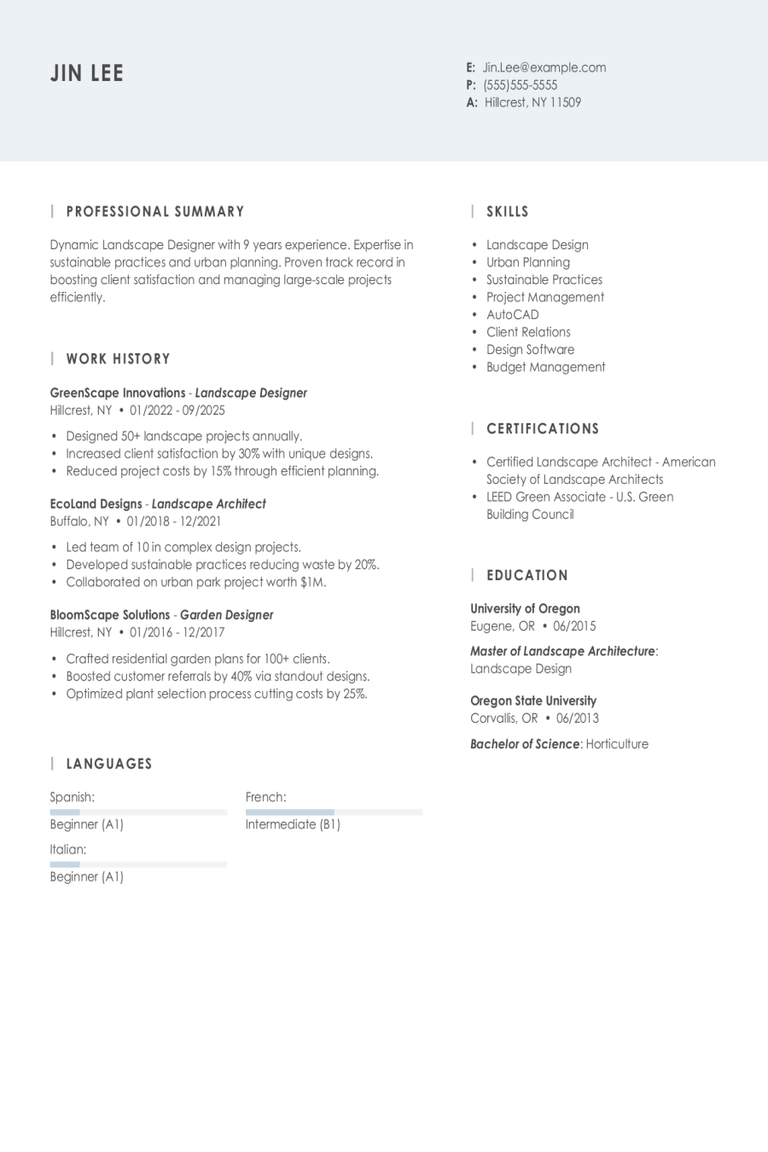
Landscape Designer Resume Examples & Templates for 2025
Browse landscape designer resume examples that show how to highlight your creativity, project planning, and plant knowledge. Learn to showcase your design skills and experience in making outdoor spaces beautiful
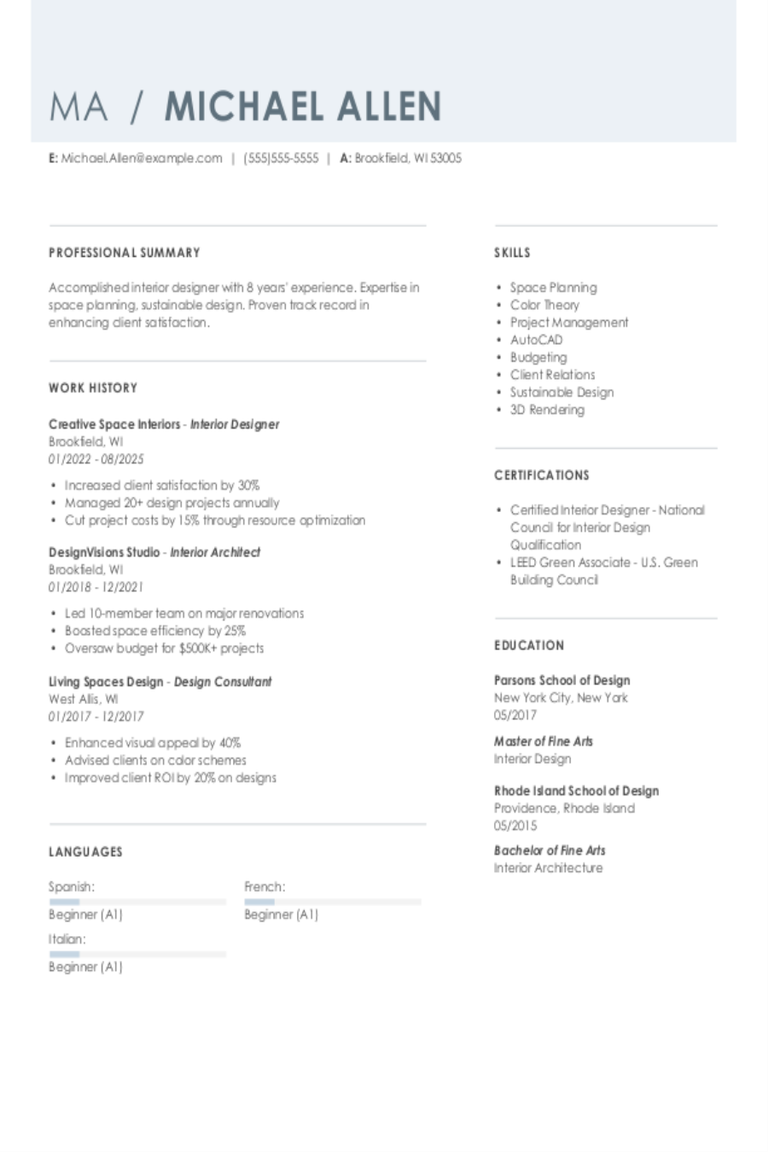
Interior Design Resume Examples & Templates for 2025
Check out interior design resumes that show off creativity, style, and planning skills. Learn how to stand out by sharing your unique talents and past projects in a way that

Costume Designer Resume Examples & Templates for 2025
Browse costume designer resume examples and tips to learn how to showcase your experience bringing creative visions to life, working with fabrics, and collaborating with directors.Build my resumeImport existing
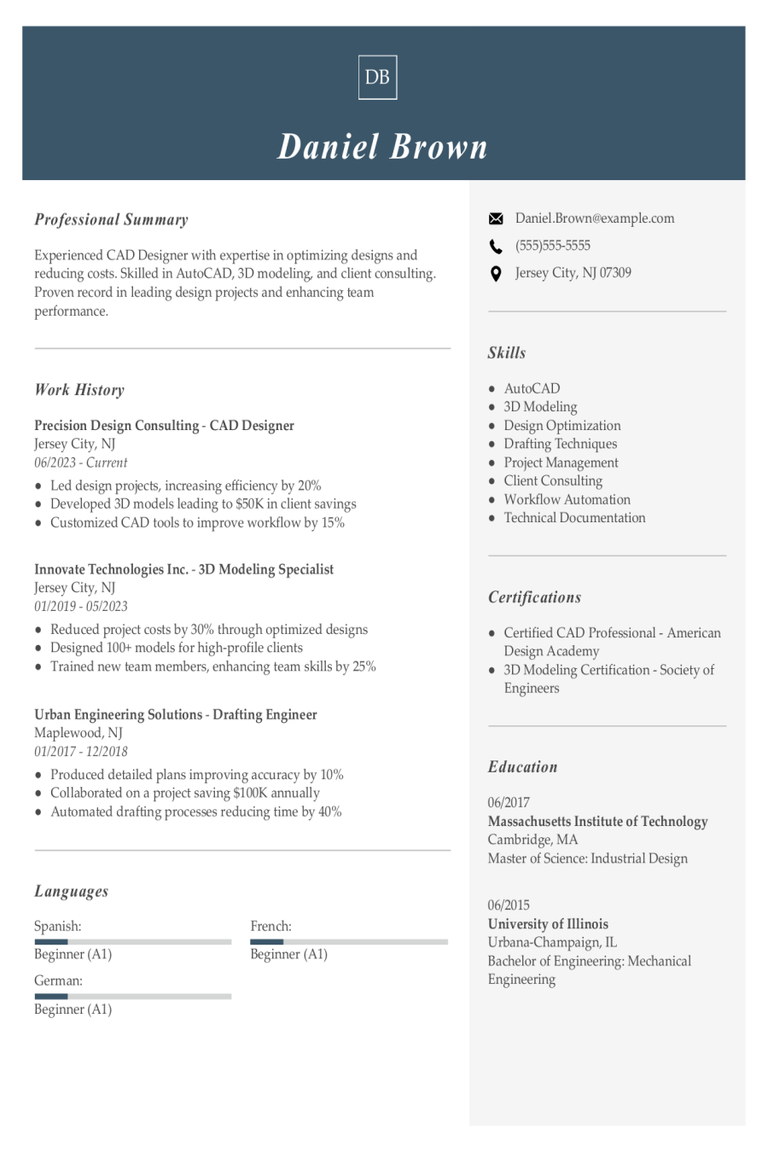
CAD Designer Resume Examples & Templates for 2025
Discover how to craft a standout CAD designer resume with our samples and tips. Learn to showcase your design skills, software knowledge, and project experience to catch the attention of
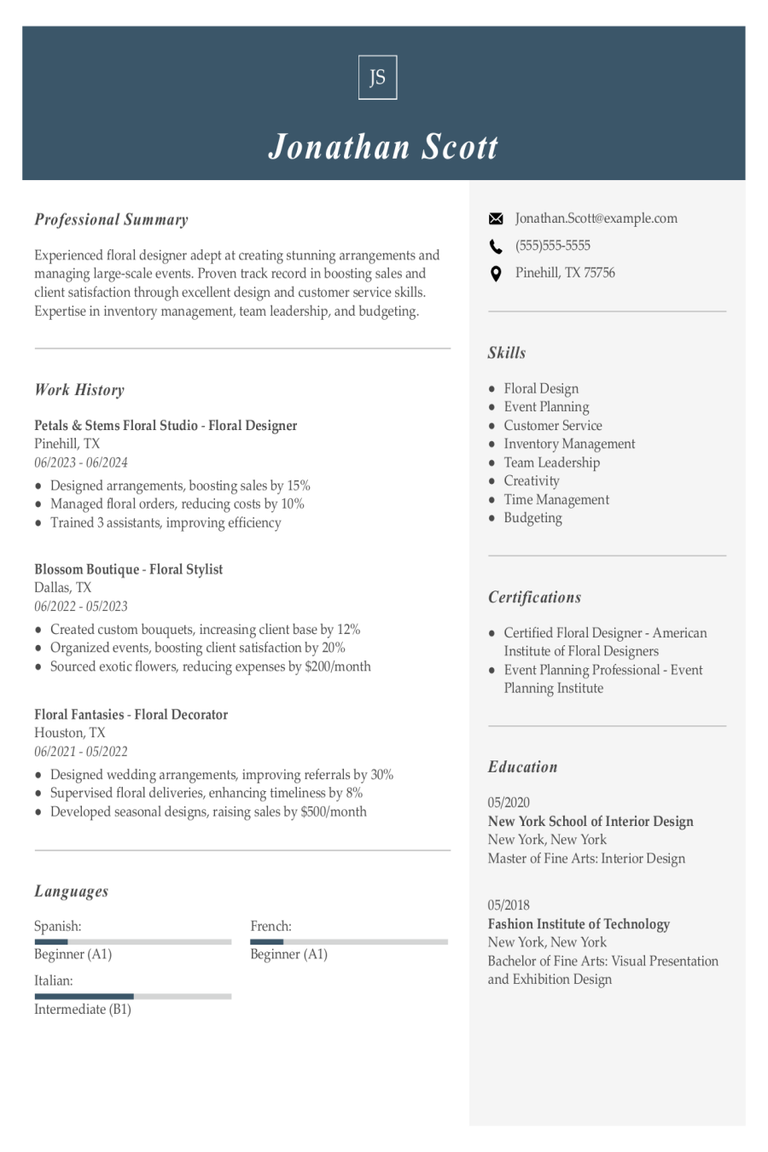
Floral Designer Resume Examples & Templates for 2025
Discover how floral designers showcase creativity and design skills in their resumes. Use these examples and tips to learn how to highlight your floral arrangement, customer service, and event planning
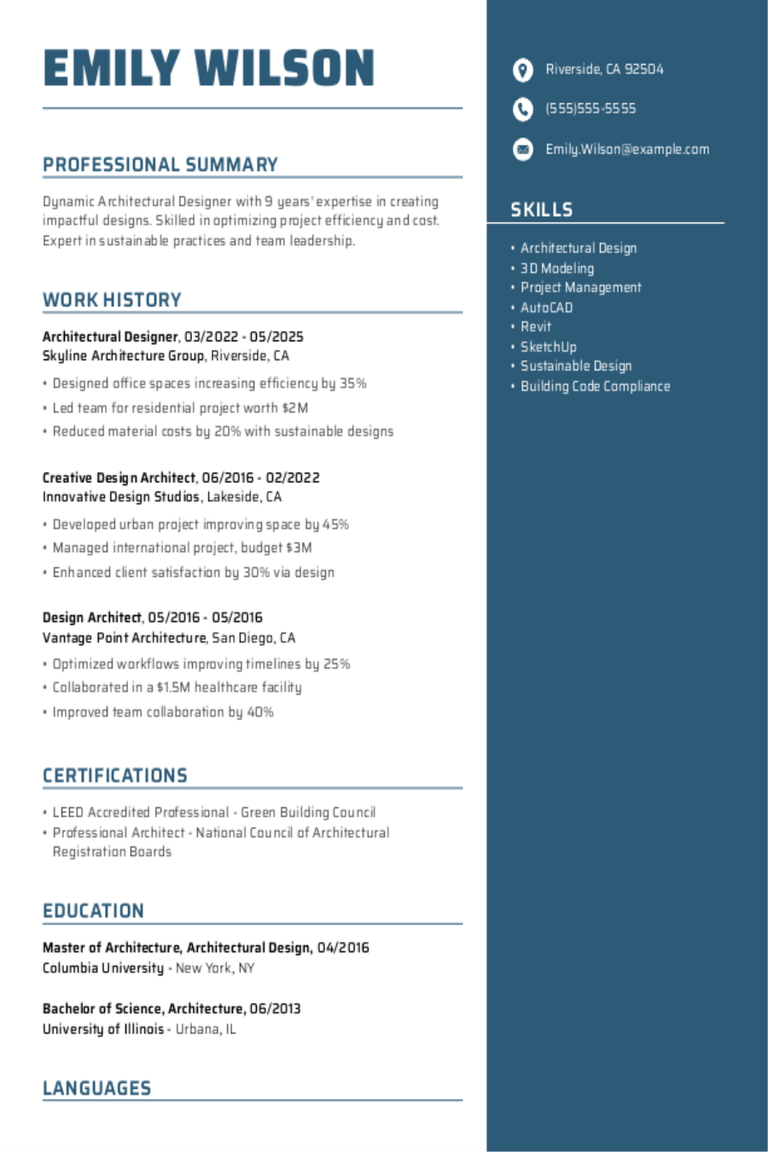
Architectural Designer Resume Examples & Templates for 2025
Explore architectural designer resume examples that show how to highlight your creativity, technical skills, and experience with design software.Build my resumeImport existing resumeCustomize this templateWhy this resume worksQuantifies accomplishments: The applicant’s
